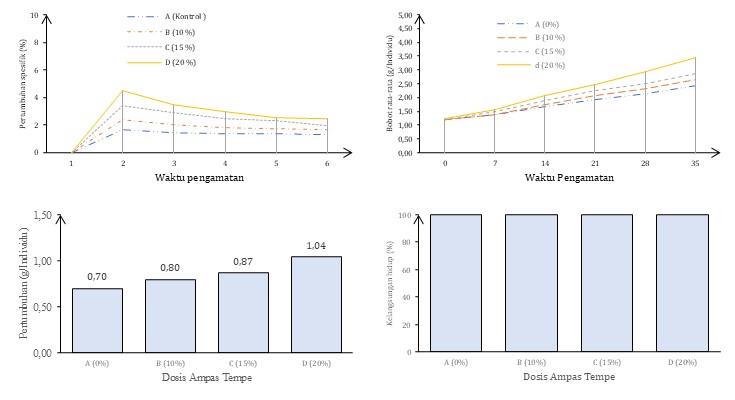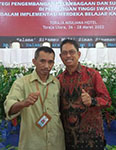Akuatikisle: Jurnal Akuakultur, Pesisir dan Pulau-Pulau Kecil
Full Length Article
Utilization of tempe dregs for the growth of tilapia fish (Oreochromis niloticus)
Highlights
Generate NLP AI by Wizdam ID.
Abstract
The objective of this study is to determine the impact of feeding tempeh dregs at varying doses on tilapia growth and survival (Oreochromis niloticus). The study was conducted from March to May 2023 in Wataliku Village, Kabangka District, Muna Regency. The study employed a completely randomized design with four treatments that involved the administration of tempeh dregs in the diet. These were designated as follows: treatment A (control) was commercial feed; treatment B was 10% tempeh dregs; treatment C was 15% tempeh dregs; and treatment D was 20% tempeh dregs. Each treatment was replicated three times. The data were subjected to analysis of variance (ANOVA) at a confidence level of 95% (α0.05). The study results demonstrated that the highest specific growth was observed with the addition of 20% tempe dregs, with an average of 2.97% per day. This was followed by 15% tempe dregs (2.47% per day), 10% tempe dregs (2.28% per day), and commercial feed (2.00% per day). The highest absolute growth was observed in the treatment that included 20% tempe dregs, with an average of 1.04 g per individual. This was followed by the treatment that included 15% tempe dregs (0.87 g per individual), the treatment that included 10% tempe dregs (0.80 g per individual), and the treatment that included commercial feed (0.00 g per individual). It should be noted that survival was 100% in all treatments. Analysis of variance (α0.05) demonstrated that administration of tempe dregs at varying doses had a statistically significant impact on the specific and absolute growth of tilapia larvae (Oreochromis niloticus).
Keywords
Introduction
Section snippets
Material and Methods
Materials and methods from the full-text PDF of this article cannot be displayed.
Results
Results from the full-text PDF of this article cannot be displayed.
Discussion
Discussion from the full-text PDF of this article cannot be displayed.
Conclusions
Conclusions from the full-text PDF of this article cannot be displayed.
Acknowledgment
Acknowledgment from the full-text PDF of this article cannot be displayed.
Competing interest
The authors declare that they have no known competing financial interests or personal relationships that could have appeared to influence the work reported in this paper.
Conflict of interest
The authors declare that the research was conducted in the absence of any commercial or financial relationships that could be construed as a potential conflict of interest.
Ethical approval acknowledgements
No ethical approval required for this article. All procedures followed were in accordance with the ethical standards of the responsible committee on human experimentation (institutional and national) and with the Helsinki Declaration of 1975, as revised in 2008 (5)
Supplementary files
Data sharing not applicable to this article as no datasets were generated or analysed during the current study, and/or contains supplementary material, which is available to authorized users.
References (1)
Boyd C. E., 1982. Water quality management for pond fish culture. Elsevier Scientific Publishing Co.
Effendie M. I. I., 1997. Biologi Perikanan. Yayasan Pustaka Nusatama: Yogyakarta, 163 p.
Haryono H. N. & Chilmawati D., 2015. Pengaruh pakan buatan dengan tepung Ikan Petek terhadap pertumbuhan dan kelulushidupan Ikan Nila Strain Larasati (Oreochromis niloticus). Journal of Aquaculture Management and Technology, 4(1): 64–70.
Karimah U. & Samidjan I., 2018. Performa Pertumbuhan Dan Kelulushidupan Ikan Nila Gift (Oreochromis niloticus) Yang Diberi Jumlah Pakan Yang Berbeda. Journal of Aquaculture Management and Technology, 7(1): 128–135.
Khairuman H. & Amri K., 2013. Budidaya Ikan Nila. PT AgroMedia Pustaka. Jakarta.
Listiyani L.,. 2018. Pengaruh Pemberian Ampas Tempe Pada Pakan Terhadap Pertumbuhan Ikan Lele Sangkuriang (Clarias gariepinus) (Sebagai Alternatif Pengembangan Untuk Pengajaran Pada Materi Pertumbuhan dan Perkembangan SMA Kelas XII Semester Ganjil). UIN Raden Intan Lampung.
Lukito A. M., 2002. Lele Ikan Berkumis Paling Populer. cod. Agromedia. Jakarta.
Nengsih E. A., 2015. Pengaruh aplikasi probiotik terhadap kualitas air dan pertumbuhan udang Litopenaeus vannamei. Jurnal Biosains, 1(1): 11–16. DOI: 10.24114/jbio.v1i1.5210
Priyadi A., Azwar Z. I., Subamia I. W. & Hem S., 2016. Pemanfaatan maggot sebagai pengganti tepung ikan dalam pakan buatan untuk benih ikan balashark (Balanthiocheilus melanopterus Bleeker). Jurnal Riset Akuakultur, 4(3): 367–375. DOI: 10.15578/jra.4.3.2009.367-375
Rahmawati A. & Dailami M., 2021. Budidaya Ikan Nila Terpadu. Penerbit Brainy Bee.
Reksono B., Hamdani H. & Yuniarti M. S., 2012. Pengaruh padat penebaran Gracilaria sp. terhadap pertumbuhan dan kelangsungan hidup ikan bandeng (Chanos chanos) pada budidaya sistem polikultur. Jurnal Perikanan dan Kelautan, 3: 41–49.
Samsu N., 2020. Peningkatan Produksi Ikan Nila Melalui Pemanfaatan Pekarangan Rumah Nonproduktif dan Penentuan Jenis Media Budidaya yang Sesuai. Deepublish.
Saparinto C., 2012. Budidaya Ikan di Kolam Terpal. Niaga Swadaya.
Subandiyono S. & Hastuti S.,. 2016. Buku Ajar Nutrisi Ikan. Universitas Diponegoro Press, ISBN: 6021065344.
Sukri S. A. M., Andu Y., Harith Z. T., Sarijan S., Pauzi M. N. F., Wei L. S., Dawood M. A. O. & Kari Z. A., 2022. Effect of feeding pineapple waste on growth performance, texture quality and flesh colour of nile tilapia (Oreochromis niloticus) fingerlings. Saudi Journal of Biological Sciences, 29(4): 2514–2519. DOI: 10.1016/j.sjbs.2021.12.027
Suyanto S. R., 2011. Pembenihan dan pembesaran nila. PT Niaga Swadaya.
Tahapari E. & Suhenda N., 2009. Penentuan Frekuensi Pemberian Pakan Untuk Mendukung Pertumbuhan Benih ikan Patin Pasupati. Berita Biologi, 9(6): 693–698. DOI: 10.14203/beritabiologi.v9i6.845
Zonneveld N., Huisman E. A. & Boon J. H., 1991. Prinsip-Prinsip Budidaya Ikan. PT Gramedia Pustaka Utama.
Bibliographic Information
Cite this article as:
-
Submitted
12 June 2024 -
Revised
22 July 2024 -
Accepted
27 July 2024 -
Published
30 July 2024 -
Version of record
15 December 2024 -
Issue date
30 November 2024
-
Academic subject
Aquaculture; Fisheries Science
Keywords
Copyright
Sangia Advertisement
Copyright © 2024 Julham Maulit, Abdul Rakhfid, Rochmady, Budiyanti, Karyawati. Sangia Research Media and Publishing. Production and hosting by Sangia (SRM™).  This work is licensed under a Creative Commons Attribution-ShareAlike 4.0 International License.
This work is licensed under a Creative Commons Attribution-ShareAlike 4.0 International License.
Disclaimer: All claims expressed in this article are solely those of the authors and do not necessarily represent those of their affiliated organizations, or those of the publisher, the editors and the reviewers. Any product that may be evaluated in this article or claim that may be made by its manufacturer is not guaranteed or endorsed by the publisher.










